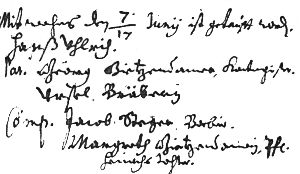
Mitwochen den 7/17 Junij ist getauft worden
Hans Ulrich
Par. Georg Gietzendanner, Kantengiesser
Ursul Bräkerin
Comp. Jacob Steger Barbir
Margreth Gietzendannerin, Jfr.
Heinrichs Tochter
Hans Ulrich Giezendanner alias Hanss Ulrich
Giezendanner, Hans Ulrich Giezedaner, Hans Ulrich Diessendanner, John
Ulrich Giessendanner, John
Ulrich Gissendanner and John Ulrich
Giezendanner,
goldsmith and pietist in Switzerland and Germany; farmer,
goldsmith and religious leader in Orangeburgh, SC,
born at Mogelsberg, Lichtensteig, Toggenburg, Kanton St Gallen in
Switzerland,
christened in Lichtensteig, St Gallen (Switzerland) on June 17,
1686; = June 7, 1686 (Old Style)
(sponsors were Jacob Steger and Margreth Giezendanner),
 |
1686: Mitwochen den 7/17 Junij ist getauft worden Hans Ulrich Par. Georg Gietzendanner, Kantengiesser Ursul Bräkerin Comp. Jacob Steger Barbir Margreth Gietzendannerin, Jfr. Heinrichs Tochter |
Sponsor Jacob Steger was married to Margreth Kunz, who was the half-cousin of Hans Ulrich.
G. D. Bernheim, in his pioneering work on German settlements in the Carolinas, discovered many irritating gaps in their early history. One of the troublesome problems was the background and religious affiliation of John Ulrich Giessendanner, who served the German and Swiss settlers around Orangeburg. Giessendanner was, by Bernheim's deduction, "an ordained minister and a native of Switzerland, and was the first and at the time, the only minister of the gospel in the village and District of Orangeburg. Further argumentation also led Bernheim to assume that Giessendanner was Lutheran. The author has had an opportunity, through a sabbatical leave, to examine records and documents in Europe, which place Giessendanner in a different perspective.
REF: The South Carolina Historical Magazine article by H. George Anderson,
July 1966, Vol. 67, Nr.3 pgs. 129 -137
(061118 comment Joop Giesendanner: Hans Ulrich was never ordained)
The northeastern section of Switzerland
forms a rough rectangle, lying on a northwest - southeast axis
and bounded on three sides by the Rhine. The fourth side, joining
the cantons of Schaffhausen, Zurich, Thurgau, St. Gallen, and
Appenzell with the rest of Switzerland, follows a chain of lakes,
the largest of which is the Lake of Zurich. The whole area is
about sixty-five miles long and thirty-five miles wide. For three
years in the early eighteenth century Johann Ulrich Giezendanner
played a leading role in the dramatic religious movements which
swept this small corner of Switzerland. A native of Lichtensteig
in Toggenburg, Giezendanner lived in the approximate center of
the area he would dominate.
next page